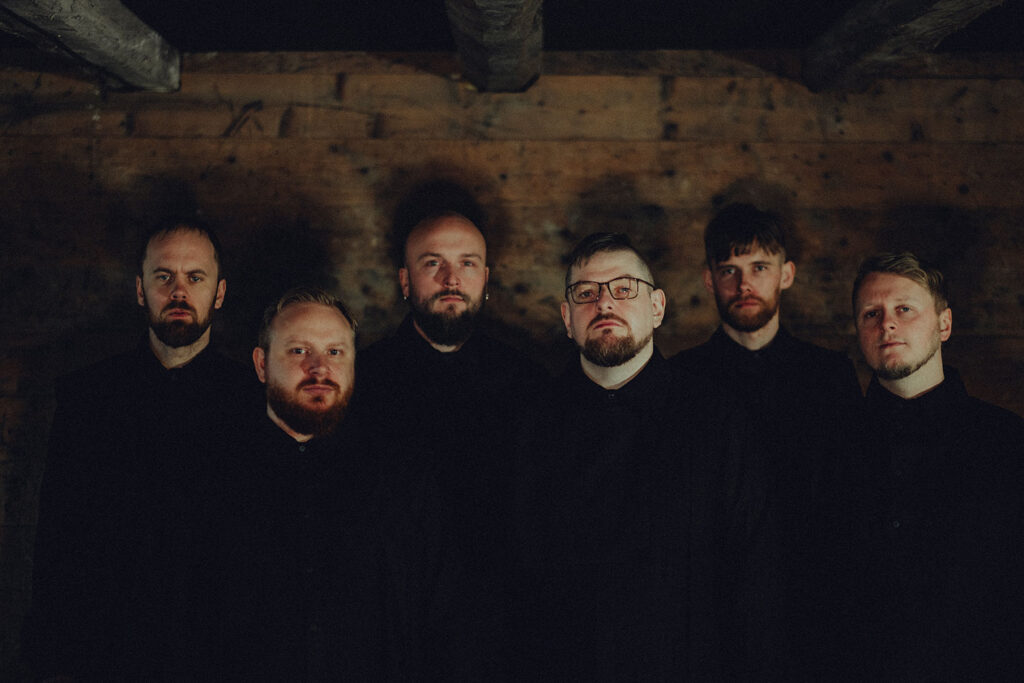
Biography

Jón Aldará: Vocals
Theodor Kapnas: Guitar
Eyðun í Geil Hvannastein: Guitar
Jenus í Trøðini: Bass
Esmar Joensen: Keyboards
Remi Kofoed Johannesen: Drums
When this magisterial Faroese death-doom sextet’s third album Támsins likam emerged in 2018 – ten years after they first entered a rehearsal space – the highly acclaimed and powerfully emotive opus thrust the mourning-suited band onto the world stage. Five years on, the accumulation of plentiful live experience and interpersonal chemistry has had a profound impact on Hamferð’s extraordinary fourth LP, Men Guðs hond er sterk, feeding into the artisanal sonic vision of guitarist and producer Theodor Kapnas.
Concertedly eschewing all the quick-fix trickery of modern recording technology, the band recorded the songs playing all together live in the studio, without a click-track. The result is a resoundingly human album that heaves, swoops and shifts in elemental style – from passages of glacial post-metallic beauty through sorrowful folky goth cadences, via icy blackened blastbeats to shuddering vistas of extreme doom mastery – with a crackling tight-but-loose interplay recalling the giants of yesteryear.
“I’m extremely fond of the aesthetic of many older records,” enthuses Theodor. “Sabbath, AC/DC, even older Slipknot. The records sound like a band playing together, it grooves in a specific way. That whole dynamic gives the music an edge which is missing in a large majority of metal released today. It’s very subjective, and I know most successful bands sound way more polished than us, but our vision was to create a record that sounds like the six of us playing together.”
After the long covid-enforced lay-off, with six busy personal lives to coordinate, uniting the whole line-up in this creative endeavour was crucial to the band. “For this record to make sense it needed to be a collaborative effort,” he insists. “When everybody plays at the same time, there’s no place to hide. Everybody gets to bring their input; the record becomes more of a collective piece than many bands are able to do today. We’ve actively tried to engage everyone as much as possible. Everybody’s got jobs and families, so you need everyone emotionally invested, feeling this is our thing and we’re all in it together.”
As well as the old-school recording set-up, Theodor’s vision for the sound is best exemplified by penultimate song Hvõlja (Whaleskin), a sluggish sludge crawl with a beautifully disgusting tone. “I had a big fascination with making stuff rougher, dirtier and uglier,” affirms Theodor. “Musically it’s all about tension; suspended chords and tense harmonies, always having that feeling of uncertainty. That penultimate song is maybe my favourite track on the record, just because it’s so uncompromising. Everything goes to 11!”
Hamferð’s first three releases were thematically linked in a fascinating reverse narrative arc. That story was concluded on Támsins likam, so this time, Theodor explains, “we started afresh. We wanted to do something completely different; still Hamferð obviously, but breaking off into something new.” The narrative concept behind Men Guðs hond er sterk is inspired by a harrowing local event: the 1915 whaling disaster off the Faroe Island village of Sandvik (home of Hamferð keyboardist Esmar Joensen), when 14 men died driving whales ashore in the stormy bay. The village population witnessed the tragedy from the seaside.
Fittingly, the sad tale has enabled Hamferð to powerfully bring to life the meaning behind their Faroese name, zeroing in on the traumatic emotional force behind this supernatural phenomenon. “When you see someone in hamferð, you see their apparition,” Theodor explains. “Mostly it’s wives with husbands at sea, who’ve seen them dripping wet in the doorframe in the middle of the night. Typically in folklore it’s a warning that something bad will happen, and there are several documented episodes of this happening in Sandvik in 1915. So it’s kind of full circle for us.”
The atmospheric closing title track contains the recorded testimony of one of the disaster’s remaining survivors, from a 1950s radio interview: “It’s describing what led up to that event, and the effect it had on the village for years. We got permission to use the interview from his daughter; she’s ninety-something and she still lives in the village, so Esmar knocked on her door and asked for her permission, which she gave us! The cool thing is that he tells of this horrible tragedy, but it has this optimistic tone, because one of the boats made it through the waves. So instead of focusing on the dark parts, his strongest emotional perspective was of the miracle that saved them.” Thankfully, the lyrics and testimony will be printed in both Faroese and English, ensuring that this epic story will captivate a wider audience.
Men Guðs hond er sterk track-listing
01 Ábær
02 Rikin
03 Marrusorg
04 Glæman
05 Í Hamferð
06 Fendreygar
07 Hvõlja
08 Men Guðs hond er sterk
Translation:
Album title: But Strong Is The Hand of God
01 To The Storm
02 Driven
03 Nightmare Grief
04 The Glow
05 As Apparitions
06 Ghosts Of The Marsh
07 Whaleskin
08 But Strong Is The Hand of God
Men Guðs hond er sterk credits:
Jón Aldará – vocals
Theodor Kapnas – guitars
Eyðun í Geil Hvannastein – guitars
Jenus í Trøðini – bass
Esmar Joensen – keyboards
Remi Kofoed Johannesen – drums
Recorded and mixed by
Theodor Kapnas at Studio Bloch in Tórshavn, The Faroe Islands
Hamferð discography:
Vilst er síðsta fet LP (Tutl 2010)
Evst LP (Tutl 2013)
Támsins likam LP (Metal Blade Records 2017)
Ódn (Metal Blade Records 2019)
Men Guðs hond er sterk LP (Metal Blade Records 2023)